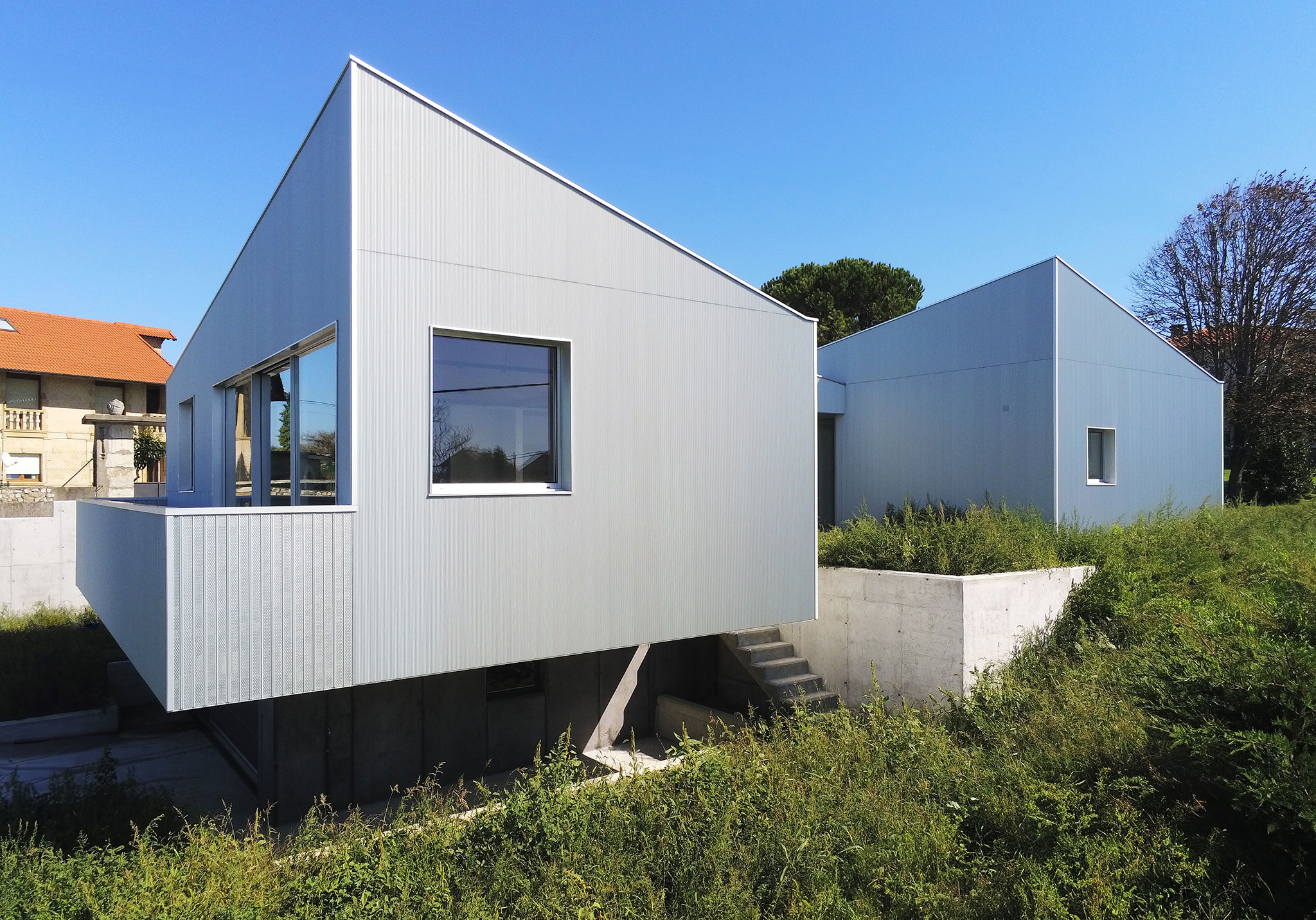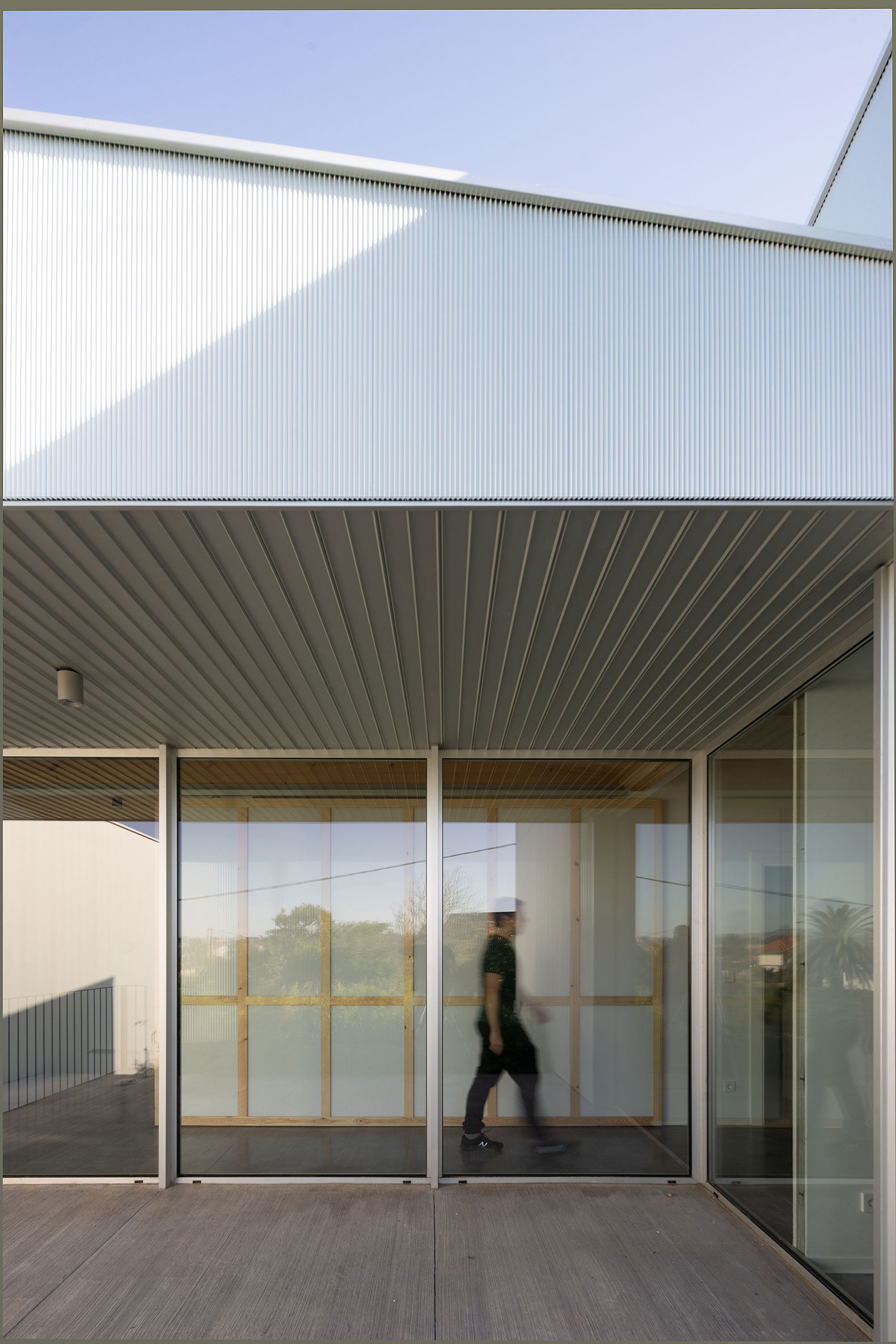The structure of the house also responds to the characteristics of the land. The garage is built with reinforced concrete walls that resolve the containment of land and the foundation while the ground floor is supported on a reinforced concrete slab and has a structure of cross-laminated wood panels on which a ventilated façade of natural anodized aluminum panels, reflecting the meaning of the name of the house in Cantabria, "silver-colored fish."

Sula house by Sukunfuku studio. Photograph by Jorge Allende.
Project description by Sukunfuku studio
The house is located on a 750 m² plot, rectangular and with an approximate difference in level of 2 meters between its ends. This elevation difference is used to create a single-story house resting on the garage, with access through the lower level.
Conditioned by the characteristics of the terrain, a two-level foundation was proposed. On the ground floor, the house rests on the existing rock at the east end, while on the west it is the volume of the garage that seeks the base firm and serves as support for the upper floor. In the center the house functions as a bridge, thus avoiding resorting to a deep foundation.
The ground floor, with a constructed area of 170 m², occupies most of the movement area of the plot, with a limited surface area, and is surrounded by other buildings. The proximity to neighboring homes and the lack of private outdoor space led to the house being organized around a central patio, the main outdoor space protected from views and facing south.
The rooms of the house are distributed around this patio, with a clear distinction between day and night areas. To the east are the bedrooms, to the west the living-dining room, and to the north a band of services and circulation.

Sula house by Sukunfuku studio. Photograph by Jorge Allende.
The interior spaces were designed to achieve spaciousness and visual connection, minimizing partitions and using flexible solutions. A large sliding panel allows you to separate, when necessary, the living dining room from the kitchen; The same element can be moved to divide the entrance hall from the rest of the house or make the office independent. In the master bedroom, a sliding door provides privacy alternatively to the ensuite bathroom or dressing room. To facilitate their maneuverability, these sliding elements are made with polycarbonate panels on a wooden frame, which gives them lightness, while allowing the passage of light from one room to another.
The size of the openings in the façade is related to the character and orientation of each space. Large windows connect the house with the central patio, serving as collectors to the south, while the north façade is characterized by smaller openings. To the west, the difference in elevation concerning the neighboring plot is used to open a large sliding window from which to contemplate the sea from inside the living room or from the outside balcony. The perforated panels used in the balustrade provide privacy from the outside while maintaining the passage of light.
The structure used responds to the conditions of the terrain. The semi-basement floor, which houses the garage, is built with reinforced concrete walls, resolving the containment of land and foundations of the complex on its lower level. The ground floor rests on a reinforced concrete slab that functions as a bridge, bridging the distance between the structural walls of the garage in the west and the rock of the terrain, which emerges very superficially at the eastern end of the plot. To reduce the thickness of the support slab, the ground floor structure is resolved using cross-laminated wood panels, which transmit a linear load on the perimeter of the slab and fulfill the double function of serving as a structural and enveloping element, thus reducing the total loads.

Sula house by Sukunfuku studio. Photograph by Jorge Allende.
A ventilated façade of natural anodized aluminum panels is installed on top of the CLT structural panels. The insulating properties of the wood, together with the ventilated façade and the thick exterior insulation, make up a highly thermally efficient envelope. The volume of the garage, not heated, leaves the reinforced concrete walls visible, both outside and inside, with a pigmented finish that contrasts with the light tone of the aluminum.
Inside, the CLT panels are left visible on the false ceilings and certain interior walls. The exterior insulation of the envelope makes it possible to dispense with interior lining in those areas where it is not necessary to run pipes. The layout of the facilities is planned to zone passage areas, conduits, and intakes, so that certain areas are freed up, leaving the wood visible.
"Sula" in Cantabria means "silver-colored fish", a reflection of the materiality of the home.






















































